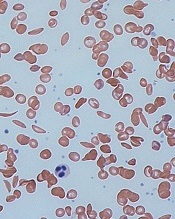
sickle cell disease
Image by Graham Beards
Researchers have described a gene-editing technique that can correct the sickle cell mutation in hematopoietic stem and progenitor cells (HSPCs) isolated from patients with sickle cell disease (SCD).
The investigators said these edited HSPCs produced wild-type adult and fetal hemoglobin.
The HSPCs were also able to engraft in mice and maintained their SCD gene edits long-term without showing any signs of side effects.
“This is an important advance because, for the first time, we show a level of correction in stem cells that should be sufficient for a clinical benefit in persons with sickle cell anemia,” said Mark Walters, MD, of UCSF Benioff Children’s Hospital Oakland in California.
Dr Walters and his colleagues described this work in Science Translational Medicine.
The researchers said they used a ribonucleoprotein complex consisting of Cas9 protein and unmodified single guide RNA, together with a single-stranded DNA oligonucleotide donor, to enable efficient replacement of the SCD mutation in human HSPCs.
The team then differentiated pools of these HSPCs into enucleated erythrocytes and late-stage erythroblasts to measure hemoglobin production.
They said the edited HSPCs produced “substantial amounts” of adult wild-type hemoglobin. The cells also showed a decrease in sickle hemoglobin and an increase in fetal hemoglobin.
When implanted in mice, the edited HSPCs repopulated and maintained their SCD gene edits for 16 weeks, with no signs of side effects. (The mice were sacrificed at 16 weeks.)
“We’re very excited about the promise of this technology,” said study author Jacob Corn, PhD, of the University of California, Berkeley.
“There is still a lot of work to be done before this approach might be used in the clinic, but we’re hopeful that it will pave the way for new kinds of treatment for patients with sickle cell disease.”
In fact, Dr Corn and his lab have joined with Dr Walters to initiate an early phase clinical trial to test this gene-editing approach within the next 5 years.
The investigators also noted that the approach might be effective for treating other disorders, such as β-thalassemia, Wiskott-Aldrich syndrome, and Fanconi anemia.
“Sickle cell disease is just one of many blood disorders caused by a single mutation in the genome,” Dr Corn said. “It’s very possible that other researchers and clinicians could use this type of gene editing to explore ways to cure a large number of diseases.”


